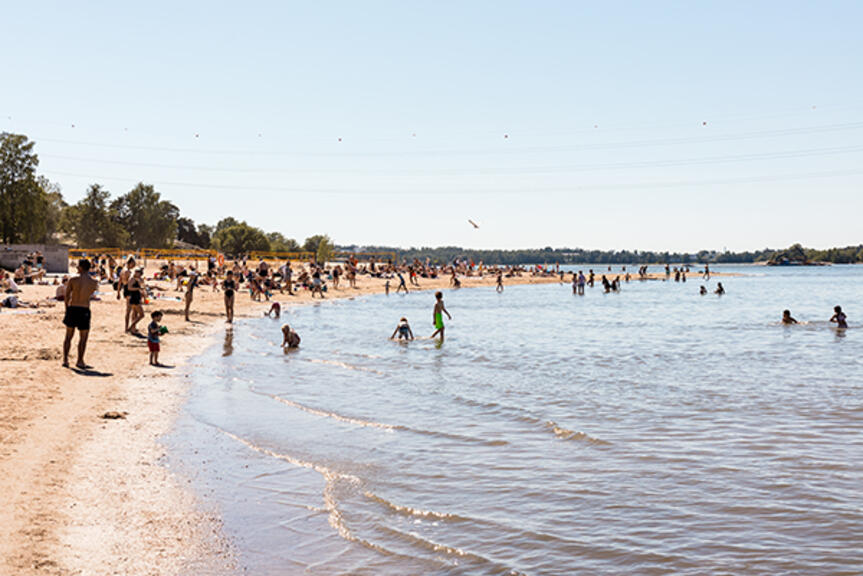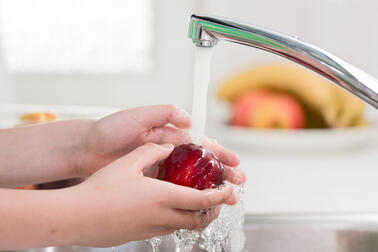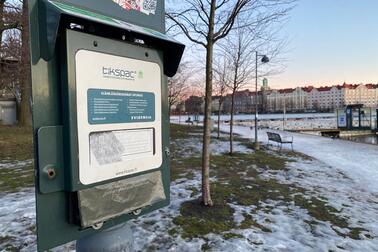
Helsinki's beach season is starting. During summer 2022, swimming is not recommended at Marjaniemi Beach and should be avoided at beaches alongside the Vantaa River during periods of heavy rain. Water quality is monitored at all beaches regularly throughout the summer. Lifeguards will supervise at the beaches between 6 June – 14 August. An amendment made to the Tobacco Act bans smoking at large public beaches.
Swimming should be avoided at Marjaniemi Beach during summer 2022
Helsinki Environmental Services recommends that swimming should be avoided at Marjaniemi Beach. The recommendation to avoid swimming will remain in force for the summer of 2022. The same recommendation was also in force for Marjaniemi Beach for the summer of 2021.
Water samples taken at Marjaniemi Beach during previous years have from time to time contained elevated amounts of intestinal enterococci. However, in the case of Marjaniemi Beach, no clear link has been found between the poor water quality test results and heavy rains. Consequently, the source of the intestinal enterococci found in the samples taken at the beach remains unknown.
Helsinki Environmental Services will perform enhanced water quality monitoring at Marjaniemi Beach during the summer of 2022. An investigation into the source of this water quality issue is ongoing.
Swimming should be avoided at beaches alongside the Vantaa River in 2022 during periods of heavy rain only
In the summer of 2022, during periods of heavy rain, swimming should be avoided at Pikkukoski Beach, Pakila Beach and Tapaninvainio Beach.
During the previous swimming season, the recommendation to avoid swimming remained in force for the entire summer at beaches located alongside the Vantaa River. For this summer, the recommendation to avoid swimming is in force during periods of heavy rain only, as based on thorough water quality investigations, at beaches located alongside the Vantaa River poor water quality test results are clearly linked with heavy rain. At beaches located alongside the Vantaa River, water quality is poor during heavy rain and immediately afterwards, as the rainwater washes soil surface microbes into the river.
Helsinki Environmental Services will perform enhanced water quality monitoring at Pikkukoski Beach during the summer of 2022. During periods of heavy rain, separate notifications to beach users will be posted at the Helsinki City web page hel.fi/uimavesi and on information boards located at the beaches. Investigations into suitable water quality improvement measures are being implemented in cooperation with various parties.
Public beaches' swimming water quality is monitored regularly
Helsinki has 25 public beaches. Most of the beaches are located on the seashore. Organized supervision is provided at the largest public beaches.
Between 1 June – 31 August 2022, water samples are taken regularly at the public beaches to assess the hygienic quality of the water via the prevalence of intestinal enterococci. In addition, water temperatures and blue-algae amounts are also monitored at the beaches. During the swimming season, Helsinki Environmental Services will visit the beaches regularly to check their situation. During these visits, various factors relevant to swimmers' health will be assessed, including the beaches' general cleanliness, the effectiveness of waste management measures and information provided on information boards.
The most recent swimming water quality test results will be presented on the beaches' information boards. In addition, reports on the swimming water quality test results and details of blue-algae observations made during testing will be posted regularly throughout the summer on the following City of Helsinki web page: Swimming water quality.
As in previous summers, the water temperatures of the beaches and blue-green algae sightings will also be updated daily on the ulkoliikunta.fi(Link leads to external service) service.
For some beaches, exact, up-to-date water temperatures are now being updated to the service throughout the year at 30-minute intervals. Up-to-date swimming water temperatures are continuously available for a total of 15 Helsinki beaches. You can check the water temperatures from the UiRas service(Link leads to external service) . It is provided on a test basis jointly by the City of Helsinki innovation company Forum Virium Helsinki and the City of Helsinki Culture and Leisure Division. Its purpose is to test the performance of low-cost IoT sensors in swimming water temperature measurement during not only the summer, but also the winter season.
Lifeguards at beaches between 6 June – 14 August
This year, Helsinki's lifeguards will supervise at the city's beaches from 6 June to 14 August. During this time, Aurinkolahti and Hietaranta beaches will be supervised by lifeguards daily from 10:00 to 20:00 while Munkkiniemi, Lauttasaari, Pikkukoski, Mustikkamaa, Tuorinniemi, Laajasalo, Marjaniemi, Rastila, Iso Kallahti, Kallahdenniemi will be supervised daily from 10:00 to 18:00, including on public holidays and Midsummer, for example.
Because of an amendment made to the Tobacco Act, smoking is now banned at all of the above-mentioned beaches. The City of Helsinki also discourages smoking at all other beaches. The primary purpose of the amendment is to protect small children from the harms of passive smoke exposure. Additionally, it aims to prevent the litter and other environmental harms caused by smoking. The smoking ban is in force on public beaches throughout the summer season, i.e., from the beginning of May to the end of September. Specific smoking have been designated next to the larger beach areas and on smaller beaches.
For this summer, specific light water-borne traffic routes have again been designated for all of the supervised beaches. Consequently, these beaches can be reached by, for example, SUP board, rowboat or kayak. In most cases, the light water-borne routes are located at the edges of these beaches.


